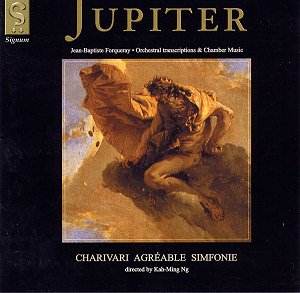Prior to hearing this disc, I was mainly aware of the
Charivari Agréable Simfonie (The Period-Instrument Orchestra
of Oxford) from their appearances on Radio 3, but the word charivari
I originally encountered as the title of a piece from Henry Cowell's
Old American Country Set (to be found on an excellent Koch CD
focusing on his "folklorist" rather than avant-garde side). Cowell's
explanation of the term was rather like its dictionary definition (A
mock serenade of discordant noises, made with kettles, tin horns, etc.,
designed to annoy and insult) but, both in his case and that of
the current ensemble, something rather more musical transpired Maybe
in this instance the agréable signifies that the noise
is actually rather pleasant.
Forqueray's music predates Cowell’s by about two hundred
years and this selection is arranged into four divertissements,
the first three consisting of three pieces each, with five in the fourth
and final group. There is a happy balance throughout between the energetic
and the lugubrious but I found the second piece on the disc (La Silva)
particularly affecting, with the viol sound approximating to that of
an Irish lament, almost recalling O'Carolan's sublime Farewell to
Music. The French origin of the music is also clearly apparent from
the recurrent folk-like inflections. Many of these works were originally
intended for viol and continuo but benefit from their ensemble treatment
(Forqueray had also arranged these pieces for solo harpsichord). The
present arrangements (for between three and seven instruments) by the
ensemble's director and harpsichord player Kah-Ming Ng and violist Susanne
Heinrich are generally exemplary.
The booklet notes concentrate mainly on the historical
and family background (particularly the turbulent relationship between
Forqueray and his father) which led to the creation of this music. They
are very thorough. The recording is balanced quite forwardly which,
to my mind, this suits the fairly intimate nature of much of the music.
The performance is unsurprisingly authentic, given the remit of the
ensemble, and playing time is very generous too. Anyone with a feeling
for this genre would find it at the very least interesting and as may
aficionados of, modern forays into the French heritage (Suites Françaises
etc - Poulenc and Milhaud), wondering where it all originated.
Neil Horner
Kirk McElhearn had previously reviewed this disc
Jean-Baptiste Antoine Forqueray was one of the leading proponents of the viol
and one of the finest musicians of his time. He had a tumultuous relationship
with his father, also a violist, who had him imprisoned because he was
jealous of his son's talent. Three years after the death of Forqueray
père, the son published a book of pieces he claimed were by his
father, although it seems that he actually wrote them. This recording
is an innovative reading of some of these works, arranged for an ensemble,
rather than for viol and continuo (Forqueray also published a version
of the same pieces for solo harpsichord.)
The music is gay and delightful, fitting in perfectly with the specific
idiom of 18th century French music for the viol. Harmonically and technically
these are demanding works, and melodically they are quite successful.
This recording features an ensemble of from three to seven musicians,
according to the individual movements. The results are somewhat mixed;
at times, the ensemble fits well with the music, providing the lushness
and depth it calls for, as in the third movement, the Chaconne, of the
first Divertissement. The interweaving of the different instruments
as the chaconne progresses is delightful, and gives the music a wonderful
texture. The pardessus de viole, however, has a slightly astringent
sound at times, and attracts a bit too much attention. The first movement
of the fourth Divertissement, La Tronchin, might sound better with a
smaller group of instruments. Its melody is less complex, and a solo
viol would bring it out much better.
The first piece, called Jupiter, a moderate movement in the first Divertissement,
has an uncanny resemblance to Michael Nyman's music in The Draughtsman's
Contract. It has a repetitive melody, and a similar instrumental sound.
Of course, Nyman used baroque music to influence his compositions for
the film soundtrack; probably not this exact music, but this gives an
idea of the tone.
The third Divertissement is the most restrained piece on this recording.
Its three movements are all played nobly and gracefully, as marked,
and are more introspective than the more lively dancing music of the
other pieces. It is perhaps here that the ensemble sounds its best,
with just four instruments, focusing more on the tone and melodies than
trying to declaim a rhythm. There is a great deal of subtle orchestration,
here; the choice of augmenting this piece, as compared to the original
scoring for viol and harpsichord, is quite good.
Overall, this is a very interesting recording. The sound is a bit overdone
at times; I would have preferred fewer instruments in some of the pieces.
But the arrangements are interesting, and the music itself is delightful
and melodically satisfying. For fans of 18th century French music, this
recording is certainly recommended.
Kirk McElhearn


